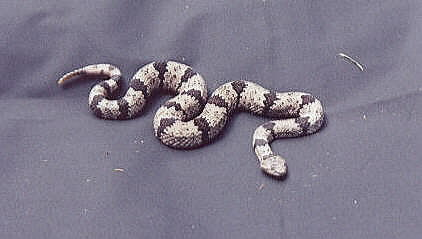Physical Description
* They are 16 - 32 5/8 (40.6-82.9) centimeters.
* The record is 82.9 centimeters.
* Skin color functions as a camouflage to blend in very
well with their surroundings.
* They have an unusual pigmentation. Both races
of rock rattlers are attractive to reptile fanciers and are protected from
capture by state law.
* This species is one of the few rattlesnakes which demonstrates
sexual dimorphism.
* The males are larger and are often colored wth a greenish-gray
hue.
* The females are bluish-grey or pinkish-tan.
* Banded Rock Rattlesnakes have widely spaced, bordered
narrow black or brown crossbands.
* They have dusky spotting betwen the bands.
* Scales are keeled in 23 rows.
*The male's tail is7.0-10.1% of the body, and the female
is 6.0-8.5%.
Rattlesnake Behaviors
* Rattlesnakes are live-bearers that protect
their young when born.
* They are dangerous and deadly animals.
* Rattlers can strike two-thirds their body length.
* Rattlesnakes are secretive and non-aggressive.
Rattlesnake Body Parts
* Rattles are a series of interlocking segments
that are bouncing against each other.
* They are hollow and made of keratin just like fingernails.
* Rattles are shaken at high speed to emit a warning.
* The rattle is developed after several sheddings of
the skin.
* The rattle is used for intra-species communication,
called caudaling.
* Rattlesnakes use their fangs, also called "hypodermic
fangs"to inject venom.
* The fangs are 3.2-3.6 mm long.
* Their tongue is used as a sensory organ to pick up
air molecules.
* They have a "pit" between the eye and the nostril that
is a sophisticatd skin membrane that can actually pick up one degree variance
in temperature up to twenty or thirty feet away.
* They don't have an auditory sensory device, They
use the pits to detect sound.
|
